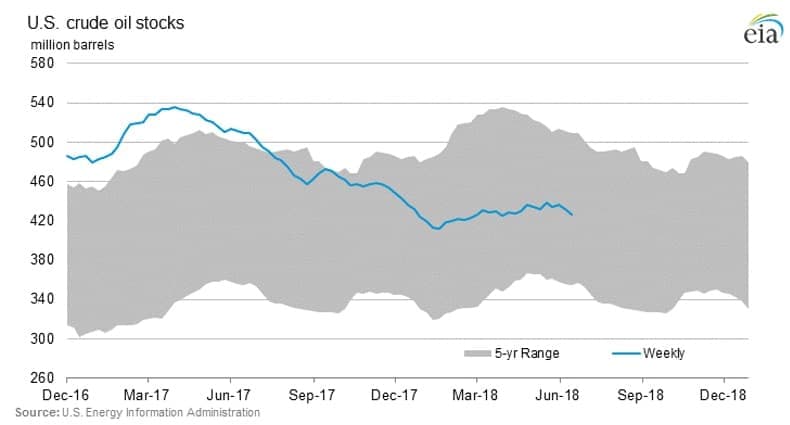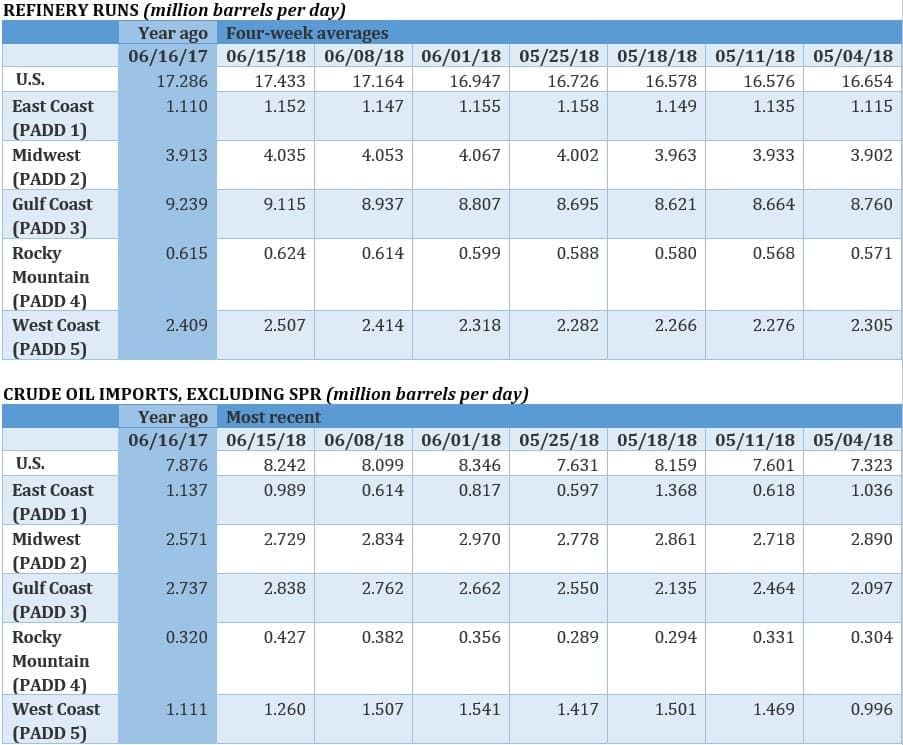OPEC has finally met, and as most expected, the cartel agreed that any country within the group that has space capacity will be able to boost oil production, with Saudi Arabia and Russia arguably standing to gain the most.

(Click to enlarge)

(Click to enlarge)

(Click to enlarge)

(Click to enlarge)

(Click to enlarge)

(Click to enlarge)

(Click to enlarge)
OPEC issued a communique on Friday that called on a return to 100 percent compliance for the group, down from 152 percent in May. The announcement deferred country-specific allocations, likely because they could not agree on the details. The decision likely means that any country with spare capacity will be able to boost production. In practice, Saudi Arabia and Russia will carry the lion’s share. How individual countries make decisions about how much to produce, while still trying to stay below a collective cap, opens up a lot of uncertainty.
Oil up on vague outcome. Oil prices moved up on Friday morning, on expectations that the result from the OPEC+ meeting won’t lead to a supply glut. In recent days, there seemed to be a bit of convergence on a plan to boost production, perhaps by around 600,000 bpd. That amount would merely offset the declines from Venezuela over the past year, and would not plug the entire supply deficit facing the market. “The market caught up a little in terms of realizing that the rumored increase was less than what is necessary to balance the market,” Emily Ashford, director of energy research at Standard Chartered, told the WSJ. “Any increase in production will come at the expense of spare capacity so that leaves the market much more vulnerable to future supply shocks,” she added.
OPEC eyed 1 mb/d increase, but couldn’t agree. OPEC’s technical committee recommended a supply increase of about 1 million barrels per day, although press reports widely noted that such an increase would likely only be nominal, and actual barrels put onto the market would reach only about 600,000 bpd because several countries have no ability to boost output. The recommendation came even as Iranian oil minister Bijan Zanganeh walked out of a meeting on Thursday night, although he met with his Saudi counterpart Friday morning. The discord likely led to the vague decision on 100 percent compliance, rather than on country-specific increases. Related: OPEC Edges Closer To Production Agreement
Oil and gas methane emissions higher than expected. A new study finds that the oil and gas industry might be leaking more methane from operations than is commonly thought. The study puts the methane leakage rate at about 2.3 percent of total production, or 60 percent higher than the EPA estimates. The difference is the equivalent of heating 10 million homes, and it also cancels out some of the net climate benefit that comes from switching from coal to gas for electricity.
EPA to put biofuels obligations onto large refiners. In a sign of retreat after outrage from the biofuels and corn ethanol industries, the EPA is reportedly set to propose putting biofuels obligations onto large refiners. The agency had issued a series of waivers to smaller refiners, allowing them to get out of buying and blending biofuels, to the anger of the ethanol industry. After the political fallout, the EPA seems to be reversing course, but will shift those requirements onto large refiners. The move is a sign of the political power of the corn lobby, as well as Midwestern Republicans in Congress.
Kimmeridge exits Carrizo, after activist campaign. Activist private equity group Kimmeridge Energy Management sold its position in Carrizo Oil & Gas (NASDAQ: CRZO) this week after a campaign to try to change the company’s strategy. Kimmeridge tried to get Carrizo to sell its oil fields in the Eagle Ford and to shift the company’s focus to the Permian. However, Carrizo resisted and Kimmeridge ultimately decided to sell its 8.1 percent stake. Maintaining Eagle Ford assets turned out to be a winner, now that Permian prices have plunged because of pipeline constraints.
U.S. natural gas output to soar 60 percent. A new report from IHS finds that U.S. natural gas production could jump 60 percent over the next 20 years, a finding that suggests the shale gas revolution has decades of running room. Dry gas production could hit 81 billion cubic feet per day this year, but rise to 118 bcf/d by 2037. Natural gas is expected to capture about 50 percent of the electricity market by 2040, up from about a third today.
Libyan forces retake oil terminal. Libya briefly saw the outage of about 450,000 bpd of supply because of attacks from militants, combined with the destruction of several oil storage tanks. Reuters reports that East Libyan forces have retaken the shuttered oil ports of Es Sider and Ras Lanuf, the two largest in the country. The three storage tanks that were destroyed will take years to repair. “Libyan production is very low but we are going to resume very soon,” Mustafa Sanalla, chairman of Libya’s National Oil Corp., told reporters in Vienna. “After a couple of days we will resume, we start our operations hopefully.”
Related: Permian Bottlenecks Begin To Bite
Permian DUCs to rise. Pipeline bottlenecks are forcing Permian drillers to leave more and more wells uncompleted. The drilled but uncompleted wells (DUCs) has more than doubled from the start of 2017, and should continue to rise as Permian pipelines fill up. “Some companies will have to shut in production, some companies will move rigs away, and some companies will be able to continue growing because they have firm transportation,” Pioneer Natural Resources (NYSE: PXD) CEO Scott Sheffield said.
Corpus Christi port receives funding for upgrade. The Port of Corpus Christi approved $217 million for upgrades to equip the facility to handle large oil tankers. The 1-million-barrel Suezmax and the 2-million-barrel VLCCs can only partially load at the facility right now. The upgrade will expand the port’s – and the country’s – export capacity.
By Tom Kool for Oilprice.com
More Top Reads From Oilprice.com:
- What Will Follow The Age Of Oil?
- Tesla Closing Down Solar Capacity
- The U.S.-China Trade War Is Great News For OPEC



















Take soybeans, for example...here is one of the grains with a very decent average daily volume to feel comfortable enough to call it "liquid" in the sense one can get in and out of the market with very little "slippage". But its price is governed by the laws of supply and demand.
Just look at today's (Friday) activity on WTI: The low is higher than the previous day's close, the open was closer to 1% up already, with an almost $4 spread between the session high and low one would think we are down to our last drop of oil. Nope. An agreement was made to increase supply and the price soars?! The absolute velocity of how far and how fast these prices surge is beyond any other investment I've ever heard of. It might as well be guaranteed surging gains for producers and bullish hedge fund managers.
Today we were in the mid-$60s and now the $60s are practically gone. Let's be honest...on a "down" day in WTI, most of those dips are far more modest and are almost always recovered before the pits close at the NYMEX under "short covering". But every "up" day with WTI always has prices hovering near session highs all the way until the market closes for the day. The opposite of short-covering is called "long unwinding" which may sound weird because it rarely if ever happens!
For so many consecutive weeks this year it has been months of increases in oil rig count data (from Baker Hughes) and it's always ignored by the market--never any real movement or changes in price. But today shows a dip of 1 and prices move even higher on that news. It's such a double standard. Bearish data from API and EIA reports rarely have any lasting effect, a stronger dollar, and reports of record production of oil in the U.S. means nothing to hedge fund managers who do the bulk of trading via algorithms.
The margin requirements for a futures contract on August 2018 WTI are currently $2,805 plus round-trip commissions and fees. Each contract holds 1,000 bbl. That means that those that actually determine the price of a globally used commodity pay approx. $2.81/bbl, which is a far cry from the almost $70/bbl that the whole world must now pay for oil. It's analogous to a relatively small group of highly privileged individuals enjoying an expensive meal of gargantuan proportion--which most people cannot afford--food that was grown and prepared by others--only to have those diners get up afterwards and have someone else clean up the mess they made from this meal AND pay their bill!
However, the fact remains, oil is and always will be the fuel of the future.
EV's will run out of batteries (which incidentally are charged by fossil fuel burning generators and not by some inefficient wind turbine which costs more to maintain and keep than the revenue it generates).
Oil is going nowhere son, but dream on.
Have you worked out where you will dispose of the toxic waste from the spent EV batteries...where you planning to put it ?? Landfill ??
Not very clever are we Sonny.